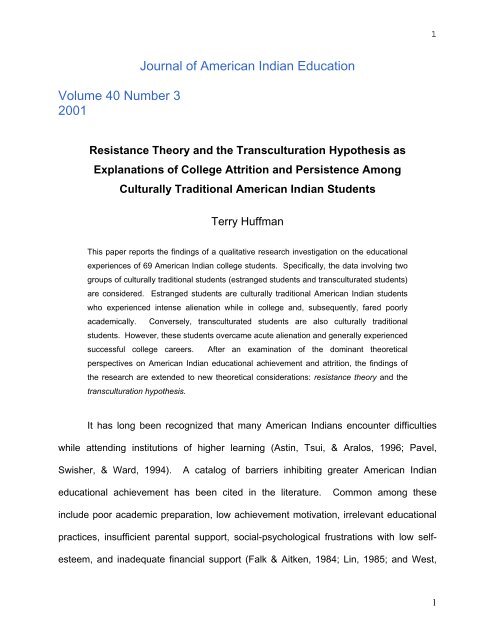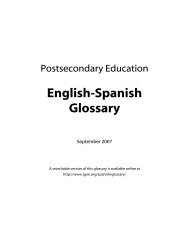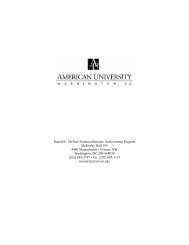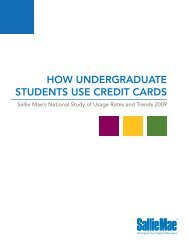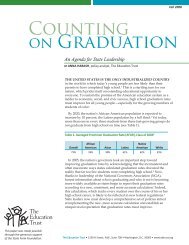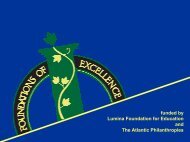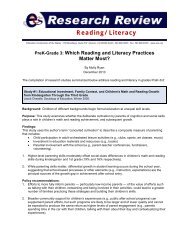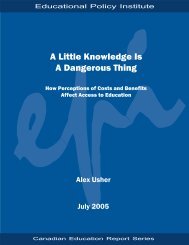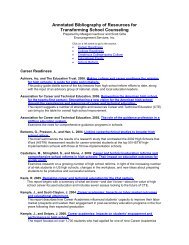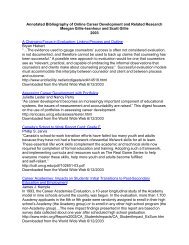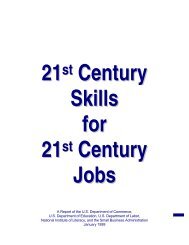Resistance Theory and the Transculturation Hypothesis
Resistance Theory and the Transculturation Hypothesis
Resistance Theory and the Transculturation Hypothesis
You also want an ePaper? Increase the reach of your titles
YUMPU automatically turns print PDFs into web optimized ePapers that Google loves.
3achievement. Likewise, Schiller <strong>and</strong> Gaseoma (1993) also reported that, despite acutecultural conflict, <strong>the</strong> retention of cultural traditionalism could serve to enhance <strong>the</strong>potential for American Indian academic achievement.Thus, it appears that for some culturally traditional American Indians <strong>the</strong>difficulties presented by cultural conflict are simply too great to overcome <strong>and</strong> an earlyexit from college is <strong>the</strong> unfortunate result. However, while <strong>the</strong> cultural incongruities <strong>the</strong>yencounter are certainly serious, o<strong>the</strong>r culturally traditional American Indian studentsmanage to resist <strong>the</strong>se barriers <strong>and</strong> persevere.Such a phenomenon raises an important question. Specifically, why do someculturally traditional American Indians fall victim to cultural conflict <strong>and</strong> do not succeedin <strong>the</strong>ir higher educational attempts while o<strong>the</strong>rs overcome <strong>the</strong> challenges presented bycultural conflict <strong>and</strong> complete <strong>the</strong>ir educational journeys? This paper examines <strong>the</strong>subjective experiences of two groups of culturally traditional American Indian collegestudents. One group of students did not complete <strong>the</strong>ir academic pursuits while <strong>the</strong>o<strong>the</strong>r group did demonstrate successful academic experiences. The purpose was toexplore those subjective experiences in order to gain insight into <strong>the</strong> possible differingways <strong>the</strong>se two groups encounter cultural conflict while in college.Prevailing Theoretical FrameworksGenerally, <strong>the</strong>re are two relatively clearly identifiable <strong>the</strong>oretical frameworksregarding <strong>the</strong> nature of cultural conflict associated with minority education. Moreover,each orientation focuses on different levels of social life. These <strong>the</strong>oretical frameworksare generally referred to as <strong>the</strong> cultural discontinuity hypo<strong>the</strong>sis <strong>and</strong> macrostructural3
4explanations.Cultural Discontinuity Hypo<strong>the</strong>sisEmerging from <strong>the</strong> early work of anthropologists such as Franz Boas <strong>and</strong> BronislawMalinowski <strong>and</strong> finding refinement among individuals like Dell Hymes (1974), <strong>the</strong>cultural discontinuity hypo<strong>the</strong>sis is certainly <strong>the</strong> more popular of <strong>the</strong> two <strong>the</strong>oreticalorientations on cultural conflict found in <strong>the</strong> American Indian education literature. Thisframework emphasizes <strong>the</strong> differing <strong>and</strong> opposing micro-level cultural elements (i.e.,communication styles, social values, interpersonal behaviors) that ultimately impacteducational performance.The disjunction between non-Indian cultural expectations institutionalized inAmerican higher education <strong>and</strong> American Indian cultural traditions <strong>and</strong> ways initiallyplaces many American Indian students at a disadvantage in college (Deloria, 1978;Garcia & Goldenstein Ahler, 1992; Garrett, 1995; Pottinger, 1989; <strong>and</strong> Swisher &Deyhle, 1989). In fact, Jon Reyhner (1992) contends that micro-level culturaldiscontinuities are probably <strong>the</strong> leading cause for high American Indian educationalattrition rates. In scathing criticism, leading American Indian scholar Vine Deloria(1990) put <strong>the</strong> matter very bluntly:[Previous American Indian educational effort] resembles indoctrination more than it doesforms of teaching because it insists on implanting a particular body of knowledge <strong>and</strong> aspecific view of <strong>the</strong> world, which often does not correspond to <strong>the</strong> life experiences that[Native] people have or might be expected to encounter. (p. 16)4
5Macrostructural ExplanationsAlthough not as clearly labeled in <strong>the</strong> literature as <strong>the</strong> former framework, <strong>the</strong> secondmajor <strong>the</strong>oretical orientation on cultural conflict may be referred to as macrostructuralexplanations. This perspective assumes that social/structural forces beyond <strong>the</strong> realmof <strong>the</strong> individual are <strong>the</strong> source of cultural conflict <strong>and</strong>, as such, are responsible for <strong>the</strong>lack of educational success among minorities. In effect, “children’s school learningproblems are ultimately caused by historical <strong>and</strong> structural forces beyond <strong>the</strong>ir control”(Ogbu, 1985).Perhaps best represented by <strong>the</strong> work of anthropologist John Ogbu (1978, 1981,1982, 1987), macrostructural explanations contend that cultural discontinuity scholarsfocus too heavily on micro-level phenomena that are in reality only <strong>the</strong> trappings of truecultural dilemmas. Ogbu likens <strong>the</strong> educational experience of American Indians tothose of o<strong>the</strong>r “castelike minorities” (1978, p. 217). For Ogbu, racial minorities(including American Indians) have been subjugated to a racially inferior status <strong>and</strong>subsequently are continually afforded a virtually meaningless educational menu.Moreover, for racial minorities in <strong>the</strong> United States, life changes are restricted <strong>and</strong>relatively predictable. Because of a social status that operates much like a caste in ahighly regimented society, opportunities for educational (<strong>and</strong> particularly economicsuccess) are scarce. Thus, <strong>the</strong> fate of racial minorities, educational <strong>and</strong> o<strong>the</strong>rwise, istied to <strong>the</strong> social/structural composition of society itself.MethodThis paper results from a five-year research project involving in-depth interviews with 695
6American Indian (predominantly Lakota) college students. The major purpose of <strong>the</strong>research was to explore <strong>the</strong> personal perspectives of American Indian students on <strong>the</strong>iracademic experiences. The research process consisted of four steps: 1) contactinginformants, 2) <strong>the</strong> initial interview, 3) follow-up interviews, <strong>and</strong> 4) data analysis.Contacting InformantsFor each semester for <strong>the</strong> duration of <strong>the</strong> research project, a list of all American Indianstudents attending a small midwestern university was obtained from that institution’scounseling office <strong>and</strong> its office of minority persistence. During this period a total of 232American Indian students enrolled in <strong>the</strong> university. Each student received a letterinforming him/her of <strong>the</strong> research <strong>and</strong> was requested to consider participating in <strong>the</strong>study. From <strong>the</strong> population of 232 students, 69 (30 percent) eventually volunteered togrant in-depth interviews.The InterviewA base instrument of 25 questions served as a guide for each interview. However, <strong>the</strong>sessions ran ra<strong>the</strong>r informally (much like a conversation) which allowed <strong>the</strong> researcherflexibility to pursue o<strong>the</strong>r relevant issues as <strong>the</strong>y arose. The interviews averaged aboutone <strong>and</strong> half hours for each session.With <strong>the</strong> permission of <strong>the</strong> student, each interview was tape-recorded.Additionally, <strong>the</strong> researcher recorded notes of each interview session in a journal. Thetranscriptions of <strong>the</strong> interviews along with <strong>the</strong> field journal notes served as <strong>the</strong> primarydata sources for this research.6
7Follow-Up InterviewsAfter initial interviews, subjects were invited to assist with follow-up interviews. Thepurpose of <strong>the</strong>se interview sessions was to track students as <strong>the</strong>y processed fur<strong>the</strong>rwith <strong>the</strong>ir educational experiences. Additionally, in some cases <strong>the</strong> follow-up sessionsallowed <strong>the</strong> researcher to clarify ambiguous responses given in <strong>the</strong> initial interview.Data AnalysisThe analysis of qualitative data is an extremely time consuming <strong>and</strong> difficult endeavor<strong>and</strong>, as such, it necessarily involves a series of steps (Strauss, 1987). The first step in<strong>the</strong> analysis of data consisted of <strong>the</strong> creation of an initial coding scheme. However,adding <strong>and</strong> collapsing categories, <strong>and</strong> refining <strong>the</strong> coding categories ultimately modifiedthis scheme.After <strong>the</strong> coding was complete, <strong>the</strong> researcher analyzed <strong>the</strong> data in an effort toexamine patterns of responses, behaviors, attitudes, <strong>and</strong> generalexperiences/perceptions.Cultural MasksThe author identified four “cultural masks” assumed by <strong>the</strong> American Indian collegestudents involved in this study (Table 1). A cultural mask is <strong>the</strong> process by which aperson comes to construct a personal ethnic identity. Moreover, a cultural mask alsoincludes <strong>the</strong> manner in which an individual uses <strong>and</strong> ultimately projects that ethnicidentity. Specifically, <strong>the</strong> cultural masks included that of: assimilated students, marginal7
8students, estranged students, <strong>and</strong> transculturated students (for a more completedescription of cultural masks see: Huffman, 1993, 1995, <strong>and</strong> 1999).Table 1Cultural Masks of American Indian College Students a________________________________________________________________Cultural Assimilated Marginal Estranged Trans- Total Maskculturated________________________________________________________________MaleN 9 7 4 6 26% 13% 10% 6% 9% 38%FemaleN 17 8 3 15 43% 25% 11% 4% 22% 62%TotalN 26 15 7 21 69% 38% 22% 10% 30% 100%Reservation BackgroundYesN 12 8 5 20 45% 17% 12% 7% 29% 65%NoN 14 7 2 1 24% 21% 10% 3% 1% 35%TotalN 26 15 7 21 69% 38% 22% 10% 30% 100%Mean Average Age25 27 26 32 28Mean Average GPA2.50 2.77 2.17 2.81 2.62________________________________________________________________aPercentages have been rounded to sum 100%While this paper specifically deals with <strong>the</strong> two more culturally traditional groupsof American Indian college students (estranged <strong>and</strong> transcultured), a brief summary of8
9all four cultural masks is in order to establish <strong>the</strong> context of <strong>the</strong> findings.Largely due to <strong>the</strong>ir cultural background before coming to college, assimilatedstudents typically identified with <strong>the</strong> college “mainstream” culture <strong>and</strong> encountered fewcultural difficulties while in college. Among <strong>the</strong> 69 students involved in <strong>the</strong> research, 26were considered to be assimilated students.Marginal students held some assimilationist orientation yet desired someidentification <strong>and</strong> affiliation with more traditional American Indian culture. Unfortunately,marginal students often felt pressure resulting from two cultural m<strong>and</strong>ates thatcomplicated <strong>the</strong>ir academic experiences. Fifteen students were identified as projectinga marginal cultural mask.Estranged students had strong identification with traditional American Indianculture <strong>and</strong> displayed an aggressive rejection of assimilation. These students viewed<strong>the</strong> mainstream as a threat to <strong>the</strong>ir ethnic identity <strong>and</strong> generally revealed a distrust of<strong>the</strong> college setting. The seven estranged students of this study encountered extremelydifficult college experiences.Transculturated students also had a strong identification with traditional AmericanIndian culture <strong>and</strong> did not aspire for assimilation. However, unlike estranged students,<strong>the</strong>se students used <strong>the</strong>ir ethnic identity as a firm social-psychological anchor <strong>and</strong>derived strength <strong>and</strong> confidence from that cultural mask. Generally, <strong>the</strong>se studentsdisplayed a confidence <strong>and</strong> sense of security that emerged from <strong>the</strong>ir American Indianethnicity. As a result, <strong>the</strong> transculturated students generally had successful academicexperiences. Twenty-one of <strong>the</strong> 69 students were identified as transculturated students.As mentioned above, this paper deals specifically with <strong>the</strong> experiences of <strong>the</strong>9
10more culturally traditional ethnic identity projections: estranged students <strong>and</strong>transculturated students. As such, an important question is how do <strong>the</strong>se similarlyculturally traditional individuals come to adopt different ethnic identities while in college?Estranged Students <strong>and</strong> <strong>the</strong> Process of EstrangementFrom <strong>the</strong> interviews with estranged students, a four-stage estrangement process wasidentified. This process included <strong>the</strong> stages of: initial alienation, disillusionment,emotional rejection, <strong>and</strong> disengagement (Figure 1). Generally, <strong>the</strong> four stages of <strong>the</strong>estrangement process seemed to follow in rapid succession. The social, emotional, <strong>and</strong>cultural isolation felt by estranged students quickly developed into <strong>the</strong> final act ofphysical detachment from <strong>the</strong> institution. Indeed <strong>the</strong> pace of estrangement isdramatically demonstrated in <strong>the</strong> fact that only two estranged students remained incollege for more than two semesters.Figure 1The Process of Estrangement________________________________________________________________STAGE ONEInitial AlienationFeelings of alienation;Little with which to relate________________________________________________________________STAGE TWODisillusionmentStrong perception of college as agentof assimilation; Extreme alienation________________________________________________________________10
11STAGE THREEEmotional RejectionRejection of perceived assimilation;Continued severe feelings of alienation________________________________________________________________STAGE FOURDisengagementPhysical withdrawal from college________________________________________________________________Stage One: Initial AlienationLargely because culturally traditional American Indian students first experienced <strong>the</strong>mainstream college as cultural “outsiders,” <strong>the</strong>ir initial feeling was one of alienation.Generally, to <strong>the</strong>se students, <strong>the</strong> institution (i.e., administration policies <strong>and</strong> procedures,even to an extent classroom etiquette, etc.) seemed rigid, overly formalized, <strong>and</strong>strangely unfamiliar.A young man who had spent his entire life on <strong>the</strong> Cheyenne River (South Dakota)reservation, who was active in American Indian religion, <strong>and</strong> reported a great deal ofdifficulties while in college (he was, in fact, nearing <strong>the</strong> end of his first semester when<strong>the</strong> first of three interview sessions took place) is typical of <strong>the</strong> impression <strong>and</strong> reactionof many culturally traditional American Indian students:. . . I felt like I’m where I don’t belong . . . I set a lot of goals, I wanted to come to school.But when I got here I found that it was really hard. I had a lot of problems with wanting toleave . . . My first impression was to get back into my car <strong>and</strong> just go home.Ano<strong>the</strong>r young man also from <strong>the</strong> Cheyenne River reservation offered a similar reaction.11
12On his initial experience in college he remarked:Overwhelmed! I felt really overwhelmed. What am I going to do? That <strong>and</strong> not seeinganybody [ano<strong>the</strong>r American Indian student]. Not for <strong>the</strong> first week, not ano<strong>the</strong>r NativeAmerican. I didn’t see anybody. And for a long time I felt that I was <strong>the</strong> only one in class.It made me feel very small, just like, but <strong>the</strong>n again sticking out like a sore thumb. I don’tknow. I wasn’t prepared for it. I really wasn’t.Many students felt overwhelmed by <strong>the</strong> lack of familiar cultural connections. Littlecontact was made with non-Indian students <strong>and</strong> <strong>the</strong> institution itself began to beregarded with suspicion (due to a growing perception that it was simply an agent ofassimilation). Often, culturally, American Indian students even felt alienated from <strong>the</strong>irfellow American Indian classmates. This social isolation was particularly evident in <strong>the</strong>attitudes toward assimilated American Indian students. These students were oftenregarded with measured contempt <strong>and</strong> dismissed as “urban Indians.”The first Cheyenne River student quoted above was typical of such sentiments:I just try to keep to myself . . . It’s like <strong>the</strong>y [assimilated American Indian students] moreor less have accepted <strong>the</strong> values of non-Indians over Indian ones . . . I was a littlest<strong>and</strong>offish . . . But I don’t ever know right off who <strong>the</strong>y are. I know <strong>the</strong>y are AmericanIndian but I don’t know who <strong>the</strong>y are . . . I guess I react to people’s reaction to me.The culturally traditional American Indians in this study were noticeably vulnerableduring <strong>the</strong> initial alienation stage. The perceived threat of assimilation compoundedwith feelings of social isolation left many students extremely discouraged.12
13Stage Two: DisillusionmentTroubled with pangs of alienation, estranged students quickly became disillusioned with<strong>the</strong>ir situation at college. The university was typically regarded as an invitation toassimilation offering only a steady diet of non-Indian culture. A student who had livednearly all his life on <strong>the</strong> Turtle Mountain (North Dakota) reservation reflected on <strong>the</strong>difficulties that he <strong>and</strong> many o<strong>the</strong>r traditional American Indian students experience:I really think <strong>the</strong>y [culturally traditional American Indian students] become disenchantedreally quick. I think <strong>the</strong>y perceive it [college] as this huge, monstrous institution ra<strong>the</strong>rthan a person walking daily. Because it’s foreign, I know for a fact that <strong>the</strong>y do suffersome sort of “culture shock” because <strong>the</strong> surroundings are new <strong>and</strong> <strong>the</strong> way of life isnew. The objectives of your time, how you spend your time, what you do, is all new. Theemphasis is placed on self <strong>and</strong> trying to fend for yourself <strong>and</strong> I think that <strong>the</strong>re are a lot ofh<strong>and</strong>icaps like that . . . I think that because <strong>the</strong> cultures are so opposed that it would be ahard transaction; that <strong>the</strong>y won’t see <strong>the</strong> benefits of it right away <strong>and</strong> might becomedisenchanted.It should be noted that <strong>the</strong> student from Turtle Mountain quoted above was not identifiedas an estranged student. He was actually a transculturated student. However, hecame to <strong>the</strong> university with a culturally traditional background <strong>and</strong> orientation <strong>and</strong> tooexperienced <strong>the</strong> same initial alienation as <strong>the</strong> estranged students. Thus his observationis applicable to <strong>the</strong> estranged students <strong>and</strong> appropriately describes much of <strong>the</strong>irexperiences.A woman who had actually lived most of her life off <strong>the</strong> reservation but had manyconnections to <strong>and</strong> spent part of her childhood on <strong>the</strong> Fl<strong>and</strong>reau (South Dakota)reservation displayed frustration with what she perceived to be <strong>the</strong> assimilationistmission of <strong>the</strong> university. This resentment underscores <strong>the</strong> profound disillusionment13
14she was experiencing:It is important to me to keep my Indian values <strong>and</strong> more or less put up with <strong>the</strong> non-Indian values because it is not for <strong>the</strong> non-Indian society that I am trying to get a degreefor. Do you underst<strong>and</strong>? ... It is hard to be an American Indian in a world that thinks thatyou should adjust to <strong>the</strong>ir type of a culture. It makes me angry at <strong>the</strong> closed minds ofpeople who will not open <strong>the</strong>ir eyes to let <strong>the</strong> Indian people be who <strong>the</strong>y were born to be.It makes me sad though, to see Native students quit because of this. I have seen ithappen many times.A similar view was offered by a young man from <strong>the</strong> Cheyenne River reservation.Comparing an American Indian worldview to <strong>the</strong> worldview he perceived as part of <strong>the</strong>college, he stated:I’m talking about college now. Everything I have, that I need to know is in a book.Everything you have is just like in that little book. Everything you need to know to get by,to get by, <strong>and</strong> to get by. Nothing but books! And this is, you ask, why? And if I comeover to this frame of mind, it’s culture lock. I get captured. So I try not to. You know, getcaptured. It’s got to be my choice. That’s where we have to keep an equality thing going[balance American Indian <strong>and</strong> mainstream worldviews in college] . . . But that’s not <strong>the</strong>way it is for us. You learn, you know, from o<strong>the</strong>rs. Not just books. Simple ways areimportant... If you’re not careful, it [American Indian worldview] could be easy to forget.It is likely that at this early stage of college life many traditional American Indians mayexhibit <strong>the</strong> greatest potential for unsuccessful academic careers (Garrett, 1995).Frustrated by disillusionment, most of <strong>the</strong> estranged students in this study left collegeheavy with <strong>the</strong> feeling of alienation <strong>and</strong> a keen desire to retain <strong>the</strong>ir cultural identity.Unfortunately, it is also quite possible that <strong>the</strong>se students st<strong>and</strong> out in <strong>the</strong> literature <strong>and</strong>serve as stereotypical models of American Indians who could not release <strong>the</strong> “old Indian14
15ways” [quotation marks added] <strong>and</strong> make <strong>the</strong> necessary adjustments to <strong>the</strong> mainstream(Scott, 1986).Stage Three: Emotional RejectionThe disillusionment many of <strong>the</strong>se American Indians felt for <strong>the</strong> higher educationalexperience quickly turned into emotional rejection of <strong>the</strong> institution. During this thirdstage <strong>the</strong> students generally reported that <strong>the</strong>y had little value for an institution <strong>the</strong>yperceived as rejecting <strong>the</strong>m. One of <strong>the</strong> young men from <strong>the</strong> Cheyenne Riverreservation came to <strong>the</strong> conclusion that <strong>the</strong> university was designed to assimilateAmerican Indian students into non-Indian society. He also emphatically added thatwhen it came to a personal choice:I believe in my Indian ways so much that I would quit school because our old ways aredying out! I don’t want to change too much, I don’t want to change too much! I want tointensify my cultural side. I mean, this is <strong>the</strong> white man’s world. I don’t want to keepthose [non-Indian values].Contemplating <strong>the</strong> same dilemma, a young, first semester freshman who had lived partof her life on <strong>the</strong> Lower Brule (South Dakota) reservation reflected:I would not give up my traditional Indian values for anything . . . There’s no beauty here[at college], you know? It’s different . . . I want to, you know, be free. To believe in what Iwant to, not what <strong>the</strong>y [non-Indians] want me to.The same young man from Cheyenne River quoted above was having a very difficulttime in his relations with non-Indians on campus <strong>and</strong> experienced profound feelings of15
16rejection. He stated:[The university] has been a different experience for me. People are very prejudicedtoward my Indian blood. Remarks <strong>and</strong> judgments are placed upon me without anyknowledge of me. It has been an extremely hard adaptation <strong>and</strong> I will be transferringbecause of it.This student, who did not transfer but dropped out of school, also illustrates that <strong>the</strong>emotional rejection stage includes <strong>the</strong> preparation for <strong>the</strong> last stage of <strong>the</strong> estrangementprocess; that of disengagement.Stage Four: DisengagementFeeling alienated, disillusioned, <strong>and</strong> rejecting <strong>the</strong> institution itself, <strong>the</strong> next step for <strong>the</strong>estranged student was <strong>the</strong> physical withdrawal from college. For many students <strong>the</strong>actual withdrawal was preceded by a brief but intense disengagement from campusactivities. Typically this disengagement took <strong>the</strong> simple form of not going to classeswhile for o<strong>the</strong>rs <strong>the</strong> disengagement was more emotional than physical.The young student from <strong>the</strong> Cheyenne River reservation quoted above describedhis emotional state <strong>and</strong> social relations shortly before his departure from <strong>the</strong> university:Lonely . . . I didn’t know anybody . . . In order to survive on campus you have to knowpeople. You have to have someone to talk to everyday, o<strong>the</strong>rwise you’ll just driveyourself down . . . I’d like to say that it [being an American Indian on a predominately non-Indian campus] isn’t a problem for me, but it is.Ano<strong>the</strong>r young man from <strong>the</strong> Cheyenne River reservation (who had already made his16
17decision to leave school when <strong>the</strong> third <strong>and</strong> last interview session occurred) describedhis impressions <strong>and</strong> feelings by stating:It was really different, it was a lot bigger <strong>and</strong> . . . it really scared me. It wasn’t my idea ofcollege. It wasn’t like what I had known [on <strong>the</strong> reservation]. All <strong>the</strong>se people walkingaround . . . There are only a few non-Indians that I’ve gotten along with. I hardly everstay <strong>the</strong>re [his dorm room], <strong>the</strong> rooms are so small <strong>and</strong> I like openness <strong>and</strong> beingoutside. I really don’t stick around on campus that much.Unfortunately, with all <strong>the</strong> emotional ingredients in place, departing from school was aneasy step for estranged students. Indeed, for <strong>the</strong>se students disengagement seemed alogical option. As a Cheyenne River reservation student lamented, “What o<strong>the</strong>r choicedo I have?”Transculturated Students <strong>and</strong> <strong>the</strong> Process of <strong>Transculturation</strong>The challenge for culturally traditional American Indian students is to interact on twocultural levels simultaneously (Garrett, 1996; Schiller & Gaseoma, 1993). That is,successful performance in college requires dual operation at an American Indiancultural level <strong>and</strong> a college mainstream level (Huffman, 1995).The transculturated students of this study displayed <strong>the</strong> unique ability to interactwithin <strong>and</strong> between cultures as dem<strong>and</strong>ed by <strong>the</strong> situation. However, <strong>the</strong> processleading through this social-psychological maze was extremely complex. Throughinterviews with students, four stages of <strong>the</strong> American Indian transculturational processwere identified: initial alienation, self-discovery, realignment, <strong>and</strong> participation (Figure17
182).Stage One: Initial AlienationVirtually all of <strong>the</strong> transculturated students began as estranged students. Therefore, likeestranged students, generally transculturated students also began as cultural“outsiders” to <strong>the</strong> campus environment. As a result, typically transculturated studentstoo were greeted by an initial alienation from <strong>the</strong> institutional setting.This first stage was an extremely painful period in <strong>the</strong> experiences of most culturallytraditional students. Students reported perplexing feelings of loneliness, isolation, <strong>and</strong>even depression. It is easy to underst<strong>and</strong> why so many estranged students left collegesoon after <strong>the</strong>ir encounters with initial alienation. Many of <strong>the</strong>se students perceived thatmuch was at stake (loss of cultural identity) with little reward in return (an educationalexperience that did not recognize or value <strong>the</strong>m).Yet, despite <strong>the</strong>se difficulties, many culturally traditional American Indian studentsmuddled through. They struggled with <strong>the</strong> feeling of being detached from <strong>the</strong> everydaylife of <strong>the</strong> campus <strong>and</strong> many reported an overwhelming sense of intimidation. Everyday of <strong>the</strong> first few months (in some cases even years) was a test to <strong>the</strong>ir commitment<strong>and</strong> endurance. A St<strong>and</strong>ing Rock (North Dakota) reservation student, who was nearing<strong>the</strong> end of his academic career, reflected:I felt like this was <strong>the</strong> last place on earth I wanted to be because <strong>the</strong>re was nothing that Icould relate to. It was all just really different . . . I had a bunch of walls around me. It washard for me to be here. I look at it as being afraid; being out of place, feeling like I wasdifferent <strong>and</strong> a lot of people treated me different . . . I just had to take it one step at atime.18
19Figure 2The Process of <strong>Transculturation</strong>________________________________________________________________STAGE ONEInitial AlienationFeelings of alienation;Little with which to relate<strong>Transculturation</strong>////////////////////////////////////////////////////////////////ThresholdSTAGE TWOSelf-DiscoveryDiscovery of personal strength emergingfrom Native cultural heritage________________________________________________________________STAGE THREERealignmentLearn to relate to both Native <strong>and</strong>mainstream cultural settings using traditionalismas an emotional anchor________________________________________________________________STAGE FOURParticipationFull use of American Indian culture<strong>and</strong> heritage as source of strength________________________________________________________________A young woman from Lower Brule recalled her first encounter with college:I would say that it was kind of like cultural shock for me because of this discipline <strong>and</strong>study habits <strong>and</strong> <strong>the</strong> pace <strong>and</strong> everything like that . . . like I said culture shock. I justdidn’t fit in, I felt like I didn’t fit.19
20Persistence for <strong>the</strong>se American Indian students was extremely difficult. Whenrecounting <strong>the</strong>se initial experiences, some students seemed surprised at <strong>the</strong>ir ownperseverance. One student from <strong>the</strong> Cheyenne River reservation exclaimed:It amazes me. I’m amazed I was able to hang on. I almost didn’t . . . I almost left, youknow, went back home . . . It was hard, boy!However, this endurance was crucial. It appears that one of <strong>the</strong> critical factors in <strong>the</strong>experiences of transculturated students is that <strong>the</strong>y remained on campus for a longerperiod of time compared to <strong>the</strong> estranged students. That is, enough time for atransformation to occur—a self-discovery.Stage Two: Self-DiscoveryIf culturally traditional American Indian students could endure <strong>the</strong> pangs of initialalienation, <strong>the</strong>y arrived at a transculturation threshold. At this point most began torealize that <strong>the</strong>y had not been snared in a web of assimilation, that <strong>the</strong>y could competeacademically, <strong>and</strong> that <strong>the</strong>y could interact with American Indians <strong>and</strong> non-Indians alike,all without loss to <strong>the</strong>ir cultural self-identity. In short, <strong>the</strong>y came to realize that <strong>the</strong>y hadnot lost <strong>the</strong>ir “Indianness” <strong>and</strong> yet <strong>the</strong>y had survived academically.Thus, many of <strong>the</strong>se students began introspection <strong>and</strong> made a most curiousdiscovery. Namely, <strong>the</strong> transcultured students came to realize <strong>the</strong>y had succeededbecause <strong>the</strong>y were American Indian <strong>and</strong> had not attempted to be anything else. Most of<strong>the</strong> transculturated students could relate a specific time in <strong>the</strong>ir academic career when<strong>the</strong>y made a deliberate decision to push forward while utilizing <strong>the</strong>ir cultural heritage as20
21a personal anchor. Reaching this transculturation threshold was often an extremelydifficult journey. However, <strong>the</strong> rewards at <strong>the</strong> end were enormous. A Turtle Mountainreservation student recalled reaching his threshold:I really had to do some searching <strong>and</strong> really some finding out; am I going to accept <strong>the</strong>way I am or am I going to try to conform or am I just going to leave it alone? Finally I hadto accept what I was <strong>and</strong> that <strong>the</strong>re are some things that are more to being an Indian thanjust <strong>the</strong> “Indian.” There was [sic] feelings <strong>and</strong> family <strong>and</strong> culture, <strong>the</strong>re was [sic] ways ofdoing things. When I learned to separate <strong>the</strong> two <strong>and</strong> learn that this is <strong>the</strong> way you do itat work, this is <strong>the</strong> way you do it at home, <strong>and</strong> you conduct your family affairs this way,<strong>the</strong>n that’s good. I think <strong>the</strong> turning point came when I decided to separate <strong>the</strong> two . . .Then I resolved my “Indianness” <strong>and</strong> <strong>the</strong> way <strong>the</strong> system works.A St<strong>and</strong>ing Rock student, who was president of his college’s honor program <strong>and</strong> <strong>the</strong>president of <strong>the</strong> campus American Indian student organization, put it this way:The first thing I found out when I came to college is how much Indian I was . . . I’d say mystrongest identification with my own “Indianness” has been since I’ve been here . . . It’s areal source of strength because I guess it sort of gives me a reason for being here.An enhanced <strong>and</strong> secure sense of ethnic identity tended to produce a more clear senseof purpose for <strong>the</strong>se students. A student from Cheyenne River reflected:I don’t feel I have to lose anything anymore. I think I have gained. That what I have isalready <strong>the</strong>re. I can’t lose it. I’m an Indian person <strong>and</strong> that’s not going to change. ButI’ve learned. I’ve learned how to grow, you know? I’ve learned how to see thingsdifferently than maybe before. But I’m still Indian. That hasn’t changed. I came to <strong>the</strong>point where I decided to be me <strong>and</strong> let everyone else, just accept everyone else. Nomore of “well this is Indian,” <strong>and</strong> “that’s not Indian.” It was just if I can relate to you that’sgood enough.21
22The changes that corresponded with this phase of self-discovery were provocative.Students generally reported <strong>the</strong>y became more relaxed <strong>and</strong> comfortable in college.Moreover, this self-discovery allowed transculturated students <strong>the</strong> ability to move into<strong>the</strong> third stage of <strong>the</strong>ir educational, cultural process, that of realignment.Stage Three: RealignmentWith <strong>the</strong> strength <strong>and</strong> confidence that <strong>the</strong>y found in <strong>the</strong>ir cultural identity, transculturatedstudents began a realignment process. At this stage, students made necessary (<strong>and</strong>practical) adjustments in <strong>the</strong>ir personal, social, <strong>and</strong> academic worlds. They generallybegan to learn how to relate at both cultural levels as dem<strong>and</strong>ed by <strong>the</strong> situation.Fur<strong>the</strong>r, at this third stage students reassessed <strong>the</strong>mselves <strong>and</strong> <strong>the</strong>ir situation. As ageneral pattern <strong>the</strong>y evaluated <strong>the</strong>ir repertoire of values, attitudes, <strong>and</strong> goals <strong>and</strong>measured <strong>the</strong>m against those institutionalized in <strong>the</strong> higher educational system. They<strong>the</strong>n began to align <strong>the</strong>mselves with <strong>the</strong> nature of academia <strong>and</strong> used <strong>the</strong> appropriatenorms <strong>and</strong> behavior as needed. In short, most learned to cross cultural boundarieswhen necessary. At this stage, <strong>the</strong>y were well into <strong>the</strong> process of transculturation.A middle-aged woman from <strong>the</strong> Pine Ridge (South Dakota) reservation, by anyst<strong>and</strong>ards a culturally traditional American Indian person (whose late fa<strong>the</strong>r was a wellknown Lakota spiritual leader), described <strong>the</strong> realignment process this way:When we go to school we live a non-Indian way but we still keep our values . . . I couldput my Indian values aside just long enough to learn what it is I want to learn but thatdoesn’t mean I’m going to forget <strong>the</strong>m. I think that is how strong <strong>the</strong>y are with me.22
23Ano<strong>the</strong>r woman also from <strong>the</strong> Pine Ridge reservation stated:My mom told us, “This is <strong>the</strong> white man’s world, you grow to learn <strong>and</strong> to live in it <strong>and</strong> at<strong>the</strong> same time try to keep your culture.” It’s kinda hard to be back <strong>and</strong> forth like this. Ithink <strong>the</strong> way I’ve taken things is to take things that you think are going to benefit you <strong>and</strong><strong>the</strong> rest you don’t bo<strong>the</strong>r with.It is important to note that for <strong>the</strong>se students realignment did not mean assimilation. Itwas <strong>the</strong> practical matter of operating within <strong>the</strong> college environment.Stage Four: ParticipationAt <strong>the</strong> fourth stage of <strong>the</strong> transculturation process most of <strong>the</strong> students settled into <strong>the</strong>routine of college. They had largely overcome <strong>the</strong> alienation of <strong>the</strong>ir early collegeexperience <strong>and</strong> discovered that it is possible to be an “Indian” in <strong>the</strong> heart of <strong>the</strong> non-Indian world. They learned that <strong>the</strong>y could interact with both American Indians <strong>and</strong> non-Indians alike. As one student from <strong>the</strong> Lower Brule reservation explained:I have my inner strength; I have my culture, my background, my traditions to fall back onto help me through. Yet I’m taking from, I would say, <strong>the</strong> white culture through education.But I’m trying to give something back too, by teaching <strong>the</strong>m [non-Indians]. And in everyclass I’ve been in I try to teach <strong>the</strong>m about our culture, about our plants, herbs, <strong>and</strong> told<strong>the</strong>m about sweat lodges <strong>and</strong> told <strong>the</strong>m, you know, about things like that <strong>and</strong> teach <strong>the</strong>mthat you can give <strong>and</strong> <strong>the</strong>n you receive back . . . I feel that I have a special advantagebecause I have two cultures that I can draw on. I can learn from here too. And I amlearning.At this stage, transculturated students appeared to be positioned to fulfill <strong>the</strong> goal ofcompleting <strong>the</strong>ir education. Importantly, to accomplish this objective <strong>the</strong>y seemed to23
24make maximum use of <strong>the</strong>ir American Indian heritage as a source of strength,confidence, <strong>and</strong> identity. The middle-aged Pine Ridge student cited above observed:I think that <strong>the</strong> time we spend away from our people, we appreciate our ways <strong>and</strong> ourpeople even more. People that have left <strong>the</strong> reservation to go away to school, I havenever seen <strong>the</strong>m participate in things like powwows or sweats or sun dances. I’ve neverseen <strong>the</strong>m do that. Yet <strong>the</strong>y go away for four or five years <strong>and</strong> <strong>the</strong>n <strong>the</strong>y come back <strong>and</strong><strong>the</strong>y are really strong into spirituality; <strong>the</strong>y’re really different. And I was thinking that <strong>the</strong>yappreciate things more when <strong>the</strong>y are away like that. They must think about it orsomething happens while <strong>the</strong>y are away.The four stages of <strong>the</strong> transculturation process were not easy but <strong>the</strong>y were rewarding.The insights offered by <strong>the</strong>se students are evidence of <strong>the</strong> daunting task involved inovercoming <strong>the</strong> initial alienation of <strong>the</strong>ir college experience.Theoretical ReconsiderationsThe recognition of two distinct groups of culturally traditional American Indian collegestudents raises an interesting <strong>and</strong> extremely important question. Why were someculturally traditional American Indian students successful in <strong>the</strong>ir college pursuits (mostnotably <strong>the</strong> transculturated students) <strong>and</strong> why were some not successful (<strong>the</strong> estrangedstudents)? The experiences of <strong>the</strong> students in this study cannot be adequatelyanswered by ei<strong>the</strong>r <strong>the</strong> cultural discontinuities hypo<strong>the</strong>sis or macrostructuralexplanations. As such, in a preliminary attempt to account for <strong>the</strong> differing experiencesamong estranged <strong>and</strong> transculturated students of this study, two different <strong>the</strong>oreticalframeworks are suggested: resistance <strong>the</strong>ory <strong>and</strong> <strong>the</strong> transculturation hypo<strong>the</strong>sis.24
25<strong>Resistance</strong> <strong>Theory</strong>According to resistance <strong>the</strong>ory, a variety of sources within <strong>the</strong> educational arena mayindict minority cultures (Erickson, 1987; Pottinger, 1989). For instance, predominantpedagogical styles, <strong>the</strong> curriculum of <strong>the</strong> school, <strong>the</strong> behavioral expectations, <strong>the</strong>personal prejudices of school personnel (among o<strong>the</strong>r factors) often convey overt <strong>and</strong>covert messages that devalue <strong>the</strong> culture, heritage, <strong>and</strong> identity of minority students.<strong>Resistance</strong> <strong>the</strong>ory asserts that during <strong>the</strong> educational endeavor, minority individualsactively resist <strong>and</strong> reject <strong>the</strong> implicit <strong>and</strong> explicit messages attacking <strong>the</strong>ir ethnic identity(Erickson, 1987). Under such conditions, educational achievement falters.Specifically, resistance <strong>the</strong>ory contends that minority students are not passive socialactors in this drama. These students actively work to protect <strong>the</strong>ir ethnic identity.<strong>Resistance</strong>, in this sense, is a means of coping with a subordinated social position aswell as preserving a distinct social identity (Ogbu, 1987). As a young man from <strong>the</strong>Sisseton reservation (South Dakota) challenged: “I believe in my Indian ways so muchthat I would quit school because our old ways are dying out!”Referring to such survival strategies, Erickson distinguishes between “culturalboundaries” <strong>and</strong> “cultural borders” (1987, p.345). For Erickson, cultural boundaries “canbe thought of as behavioral evidence of culturally differing st<strong>and</strong>ards ofappropriateness” (p. 345). Cultural boundaries are simply <strong>the</strong> fact that different groupsspeak, act, <strong>and</strong> think in distinct ways. In essence, cultural boundaries represent <strong>the</strong>normative expectations held by respective cultural groups. Moreover, Erickson stressesthat <strong>the</strong> recognition of cultural differences is itself socially <strong>and</strong> politically neutral. That is,25
26<strong>the</strong> acknowledgment of cultural boundaries is not an act of value assessment.On <strong>the</strong> o<strong>the</strong>r h<strong>and</strong>, however, cultural borders relate to <strong>the</strong> value placed on oneset of cultural expectations over ano<strong>the</strong>r. Erickson argues that cultural borders includeassessing merit to differing cultural expectations. One cultural package is deemedsuperior to ano<strong>the</strong>r. As such, cultural differences are “borders” to be protected. ForErickson, resistance to ethnic attack is border work, <strong>the</strong> active attempt to preserve anethnic identity.The estranged students in this study actively resisted what <strong>the</strong>y perceived ascultural assimilation <strong>and</strong> opted for survival strategies <strong>and</strong> engaged in <strong>the</strong>ir own borderwork. Unfortunately, as a result, most were quickly disillusioned <strong>and</strong> left college withfeelings of extreme emotional, social, <strong>and</strong> cultural isolation. They recognized <strong>the</strong>“cultural discontinuities” around <strong>the</strong>m <strong>and</strong> <strong>the</strong>y understood what <strong>the</strong>y believed to be<strong>the</strong>ir only choices: assimilate or leave. As such, <strong>the</strong>y were not blindly ambushed bycultural conflict—ra<strong>the</strong>r, <strong>the</strong>y pushed out by forces <strong>the</strong>y only vaguely understood.Generally, <strong>the</strong>se students saw <strong>the</strong> conflict for what it meant to <strong>the</strong>m <strong>and</strong> resisted it <strong>the</strong>best way <strong>the</strong>y knew at <strong>the</strong> time. Simply put, estranged students resisted by leaving <strong>the</strong>institution.The <strong>Transculturation</strong> Hypo<strong>the</strong>sisKurt Lewin (1948) argued that minority members often employ <strong>the</strong>ir ethnicity to <strong>the</strong>iradvantage. Lewin’s contention is particularly useful when applied to <strong>the</strong> experiences of<strong>the</strong> transculturated American Indian college students. The author refers to <strong>the</strong><strong>the</strong>oretical model emerging from <strong>the</strong> analysis of <strong>the</strong>se students as <strong>the</strong> transculturational26
27hypo<strong>the</strong>sis. The major dimensions of this <strong>the</strong>oretical framework are outlined below.1. American Indian Ethnic Identity as Emotional Anchor: The idea that American Indiansmust undergo a radical form of assimilation in order to achieve in higher education canbe utterly dismissed by <strong>the</strong> findings of this study. The transculturated studentsdemonstrate that cultural traditionalism need not be a “difficult situation” st<strong>and</strong>ing in <strong>the</strong>way of academic achievement (Scott, 1986). These individuals forged a strong selfidentity<strong>and</strong>, in <strong>the</strong> doing, acquired <strong>the</strong> necessary tools to interact <strong>and</strong> achieve. Theconfidence, self-worth, <strong>and</strong> sense of purpose displayed by <strong>the</strong> transculturated studentswere not in spite of being an American Indian, it was because <strong>the</strong>y were AmericanIndian.2. The Importance of <strong>the</strong> <strong>Transculturation</strong> Threshold: To arrive full of confidence inone’s identity <strong>and</strong> ability is a hazardous journey. As <strong>the</strong> estranged studentsdemonstrate, having a strong sense of one’s ethnic identity <strong>and</strong> an absolutedetermination to retain that identity were not enough to survive social-psychologicalalienation. It is not an overstatement that all of <strong>the</strong> culturally traditional AmericanIndians in this study arrived on campus as cultural outsiders. Their first experience wasthat of isolation, loneliness, <strong>and</strong> even despair. One of <strong>the</strong> most significant findings in thisstudy is <strong>the</strong> identification of a transculturation threshold. The transculturation thresholdis a more or less specific point in which some students decided to retain <strong>the</strong>ir culturalidentity, use that identity <strong>and</strong> <strong>the</strong> self-discovery that emerged as a result.A good illustration of this phenomenon is <strong>the</strong> case of a very successful student27
28from St<strong>and</strong>ing Rock reservation. His life <strong>and</strong> college experience were particularlyeventful with many personal triumphs <strong>and</strong> tragedies. He related how he ventured into<strong>the</strong> realization that his ethnic heritage <strong>and</strong> identity were his real strengths <strong>and</strong> source ofcourage.After a tumultuous beginning, this student eventually graduated among <strong>the</strong> top inhis class, was a talented writer, a highly effective campus activist for American Indian<strong>and</strong> minority rights, <strong>and</strong> had been offered a graduate fellowship at one of <strong>the</strong> nation’sleading universities. Yet, his college endeavor almost ended in failure. His first years incollege were filled with bouts with alcoholism <strong>and</strong> depression. He was intimidated byhis fellow non-Indian classmates <strong>and</strong> suffered from overwhelming timidity in interactionswith his professors. He struggled daily with <strong>the</strong> temptation to leave school.With time he began to appropriate traditional American Indian healingapproaches into his recovery efforts. Amid his recovery from alcoholism he soondiscovered that he was an equal academic competitor with non-Indian students. Herecalled coming to <strong>the</strong> conclusion that he wished to fully embrace his traditional roots.This was a dramatic <strong>and</strong> defining moment not only in his academic career but in hispersonal life as well. Describing that period of assessment he related:I decided that I was Indian. There were all <strong>the</strong>se walls around me, but <strong>the</strong>y weren’t goingto shrink any less if I were less “Indian” . . . I guess being here [in college] taught me howmuch strength <strong>the</strong>re is in being Indian. When I finally accepted that, I was on my way . . .Eventually this student was academically successful. But this success did not comeuntil after a difficult period of personal, emotional, <strong>and</strong> cultural assessment.If his was <strong>the</strong> only case of such cultural accounting, it could be dismissed as an28
29isolated case of <strong>the</strong> intimate, personal journey of one man. It was not <strong>the</strong> only case.O<strong>the</strong>r students related experiences of some type of reconciliation. Few were asdramatic as <strong>the</strong> case described above. However, virtually all described some period ofsorting through <strong>the</strong>ir situation <strong>and</strong> arriving at <strong>the</strong> conclusion to use <strong>the</strong>ir ethnic identityas personal strength. Therefore, such moments, this transculturation threshold,appears to be a critical moment in <strong>the</strong> formation <strong>and</strong> projection of <strong>the</strong> transculturatedcultural mask. It was during this time that <strong>the</strong> culturally traditional American Indiancollege students in this study moved from <strong>the</strong> estranged cultural mask to atransculturated one.3. Ability to Engage Two Cultural Settings: One of <strong>the</strong> least recognized <strong>and</strong> understoodaspects of <strong>the</strong> transculturated experience is <strong>the</strong> ability for an American Indian toeffectively engage <strong>the</strong> cultural setting of non-Indians without assimilation. The conceptof transculturation incorporates <strong>the</strong> idea that American Indian college students need notnecessarily relinquish <strong>the</strong>ir Native ways in order to be successful. Ra<strong>the</strong>r, <strong>the</strong>transculturation hypo<strong>the</strong>sis assumes that American Indian students simply increase<strong>the</strong>ir cultural repertoire adding <strong>the</strong> skills needed while keeping <strong>the</strong>ir Native heritageintact. As such, <strong>the</strong> individual is conceptualized as fully capable of interaction with twodifferent cultures without cultural loss.The transculturated students of this study clearly demonstrated this ability. Theyevidenced a capacity for cultural learning <strong>and</strong> relearning that positioned <strong>the</strong>m totraverse cultures.29
304. The Process of Cultural Learning: Just as important as cultural retention,transculturation is a process of cultural learning. To successfully engage a culturalsetting requires that <strong>the</strong> individual underst<strong>and</strong> that milieu. As such, <strong>the</strong> transculturationstudent must be able, willing, <strong>and</strong> provided <strong>the</strong> opportunity to undertake this learningprocess. Therefore, it is assumed that transculturation is as much a socializationprocess as it is <strong>the</strong> preservation of one’s former cultural heritage <strong>and</strong> identity.However, because cultural learning can be a very disorienting <strong>and</strong> intimidatingexperience, a crucial factor facilitating this learning process is that <strong>the</strong> individual needsto be secure in his/her own ethnic identity. Thus, once again we must consider <strong>the</strong>importance of <strong>the</strong> first dimension of <strong>the</strong> transculturation hypo<strong>the</strong>sis. The link is animportant one. The absence of emotional security in <strong>the</strong>ir ethnic identity appears to bea major reason many of <strong>the</strong> estranged students experienced great difficulty navigatingthrough collegiate problems. Clearly <strong>the</strong>se students highly valued <strong>the</strong>ir culturallytraditional ethnic identity <strong>and</strong> <strong>the</strong>y did not wish to risk losing that identity to assimilation.However, compared to transcultured students, <strong>the</strong> estranged students did not possess<strong>the</strong> social-psychological means to explore <strong>the</strong> trappings of unfamiliar culturalsurroundings. Their ability to actively engage in new cultural learning was seriouslycompromised by <strong>the</strong> concern of losing (or diluting) <strong>the</strong>ir cultural identity.The strength of ethnic identity has a major, but easily missed, implication fortransculturated students. Ethnic confidence <strong>and</strong> security provide <strong>the</strong> opportunity toexplore <strong>and</strong> learn <strong>the</strong> cultural setting of <strong>the</strong> mainstream. Without <strong>the</strong> opportunity forexploration <strong>and</strong> subsequent discovery <strong>and</strong> learning, it is very likely that many culturallytraditional American Indian students will find it difficult to be successful in a30
31predominantly non-Indian higher educational institution.RecommendationsThe insights gained from <strong>the</strong> interviews with <strong>the</strong>se American Indian students suggestimportant considerations for both researchers <strong>and</strong> educational practitioners.Specifically, <strong>the</strong>se insights help to inform us on future research directions as well asimplications for educational practice.Suggestions for Future ResearchWhile this study specifically examined <strong>the</strong> nature of ethnic identity as it directly relates to<strong>the</strong> academic experience, <strong>the</strong>re are many o<strong>the</strong>r facets of American Indian highereducation that may be richly explored using qualitative research designs. Simply put,<strong>the</strong>re is much to be learned regarding <strong>the</strong> way American Indian college studentsperceive, operate within, <strong>and</strong> ultimately experience higher education. For instance,future research could focus on such features as family relations, academic preparation,financial barriers, among o<strong>the</strong>rs, that are also related to <strong>the</strong> manner in which AmericanIndians experience higher education. There is little doubt that a wider examination of<strong>the</strong> personal insights of life in academia would greatly enrich <strong>the</strong> American Indianeducation literature as well as facilitating an assessment of current educationalpractices.Implications for Educational Practice31
32The culturally traditional American Indian students in this study occupied a precariousposition. While <strong>the</strong>y generally sought to retain <strong>the</strong>ir ethnic identity, to do so whileremaining in academia typically resulted in a sharp contest with social-psychologicalalienation. Ironically, if alienation among culturally traditional American Indian studentsis to be challenged, <strong>the</strong> experiences of <strong>the</strong>se students suggests that a strong, culturallytraditional ethnic self-identity is a major part of <strong>the</strong> solution. That is, a strong selfidentityserved to equip <strong>the</strong> transculturated students with <strong>the</strong> social-psychologicalsecurity <strong>and</strong> confidence necessary to engage <strong>the</strong> cultural milieu of <strong>the</strong> mainstreamcampus.Therefore, as <strong>the</strong>y directly relate to ethnic identity, several implications foreducational practice are presented for consideration.1. Need to Celebrate American Indian Ethnicity: One relatively simple way to discouragefeelings of alienation is <strong>the</strong> celebrate American Indian ethnicity on campus (Kirkness &Barnhardt, 1991).An institutional setting that is perceived as forbidding onlyexacerbates social-psychological alienation (Davis, 1992). Therefore, institutionsenrolling American Indian students could dispel some of <strong>the</strong>se perceptions by includingAmerican Indian heritage <strong>and</strong> culture into <strong>the</strong> campus environment.Specifically, <strong>the</strong>se measures could involve adorning <strong>the</strong> campus with AmericanIndian art, <strong>the</strong> art of prominent or emerging American Indian artists, <strong>and</strong> with displaysthat recognize <strong>the</strong> accomplishments of American Indian alumni. Additionally, collegescould establish regular campus American Indian cultural <strong>and</strong> educational events.Moreover, special orientation programs for entering American Indian students could be32
33created or existing programs exp<strong>and</strong>ed. This could provide <strong>the</strong> opportunity for newAmerican Indian students to become somewhat acclimated to <strong>the</strong> campus environment.2. Need for Culturally Appropriate Counseling: While <strong>the</strong> celebration of American Indianethnicity can make <strong>the</strong> campus a more comfortable setting for many American Indianstudents, it remains a cosmetic move. Ultimately, <strong>the</strong> essential test for reducingalienation (<strong>and</strong> subsequent attrition) comes through <strong>the</strong> relations with o<strong>the</strong>r individuals.It is crucial, <strong>the</strong>refore, that <strong>the</strong> human relations dimension of <strong>the</strong> American Indiancollege experience be recognized. Nowhere is this m<strong>and</strong>ate more important than <strong>the</strong>design <strong>and</strong> delivery of counseling services to American Indians (Trimble & Fleming,1989).There is evidence that culturally appropriate counseling at <strong>the</strong> higher educationallevel is an extremely important component in <strong>the</strong> persistence of American Indianstudents (Havil<strong>and</strong>, Horswill, O’Connor, & Dynneson, 1983). However, <strong>the</strong>re is also adebate over <strong>the</strong> nature of culturally appropriate counseling. On <strong>the</strong> one h<strong>and</strong>, someresearchers argue that culturally traditional American Indian college studentsdemonstrate a strong preference for racially <strong>and</strong> ethnically similar counselors <strong>and</strong>generally have ra<strong>the</strong>r specific expectations regarding <strong>the</strong> counseling experience(Havil<strong>and</strong> et al., 1983; Johnson & Lashley, 1989). O<strong>the</strong>r researchers contend thatcounselor ethnicity is not as important as perceived cultural sensitivity evidenced by <strong>the</strong>counselor (LaFromboise, Dauphinais, & Rowe, 1980; LaFromboise & Dixon, 1981).While <strong>the</strong> specifics of <strong>the</strong> debate are beyond <strong>the</strong> scope of this paper, given <strong>the</strong>experiences of <strong>the</strong> culturally traditional students in this study, it is obvious that culturally33
34appropriate counseling is greatly needed. The ideal counseling situation would likelyinclude highly trained, culturally sensitive American Indian counselors. However, <strong>the</strong>reality is that <strong>the</strong>re has been, <strong>and</strong> likely remains, a shortage of competently trainedAmerican Indian professionals (Trimble & LaFromboise, 1985). Thus, cultural sensitivitymay prove to be <strong>the</strong> key to appropriate counseling. Ultimately <strong>the</strong> burden falls oninstitutions of higher learning to ensure that <strong>the</strong>y have staffed culturally competent aswell as professionally trained personnel who are perceived as legitimate resourcesamong culturally traditional American Indian students.ConclusionPersistence of American Indians continues to be a major concern in higher education.Yet, <strong>the</strong> best alternative toward realizing educational success among culturallytraditional American Indians is to strive for achievement through cultural autonomy (VanHamm, 1996). The transculturated students of this study provide evidence thatculturally traditional American Indians can achieve academically while retaining <strong>the</strong>ircultural integrity. If more favorable graduation <strong>and</strong> persistence rates are be realized, asituation in which American Indian college students perceive <strong>the</strong> freedom to expressany ethnic identity <strong>the</strong>y chose (whe<strong>the</strong>r it be traditional or assimilated) should beencouraged. Such a situation would not solve all <strong>the</strong> problems besetting AmericanIndian higher education persistence. Never<strong>the</strong>less, it would make a positive difference.Terry Huffman, Ph.D. is an associate professor of sociology at <strong>the</strong> University of NorthDakota. He received his Ph.D. from Iowa State University. Areas of research interest34
35include family studies <strong>and</strong> American Indian studies.ReferencesAstin, A. W., Tsui, L., & Avalos, J. (1996). Degree attainment rates at Americancolleges <strong>and</strong> universities. Los Angeles, CA: Higher Education ResearchInstitute, UCLA.Carrol, R. E. (1978). Academic performance <strong>and</strong> cultural marginality. Journal ofAmerican Indian Education, 18(1), 11-16.Davis, J. (1992). Factors contributing to post-secondary achievement of AmericanIndians. Tribal College Journal, 4(2),24-30.Davis, T. & Pyatskowit, A. (1976). Bicognitive education: A new future for <strong>the</strong> Indianchild? Journal of American Indian Education, 15(3), 14-21.Deloria, V. (1978). The Indian student amid American inconsistencies. In T. Thompson(Ed.), The Schooling of Native America (pp. 9-26). Washington, D.C.: AmericanAssociation of Colleges for Teacher Education.Deloria, V. (1990). Traditional education in <strong>the</strong> modern world. Winds of Change, 5(10),16-18.Duda, J. L. (1980). Achievement motivation among Navajo students. Ethnos, 8(4),316-331.Erickson, F. (1987). Transformation <strong>and</strong> school success: The politics <strong>and</strong> culture ofeducational achievement. Anthropology <strong>and</strong> Education Quarterly, 18(4), 335-356.Falk, D. R. & Aitken, L. P. (1984). Promoting retention among American Indian collegestudents. Journal of American Indian Education, 23(2), 24-31.35
36Garcia, R. L. & Goldenstein Ahler, J. (1992). Indian education: Assumptions,ideologies, strategies. In J. Reyhner (Ed.), Teaching American Indian students(pp. 13-32). Norman, OK: University of Oklahoma Press.Garrett, M. T. (1995). Between two worlds: Cultural discontinuity in <strong>the</strong> dropout ofNative American youth. The School Counselor, 42(2), 186-195.Garrett, M. T. (1996). “Two people:” An American Indian narrative of bicultural identity.Journal of American Indian Education, 36(1), 1-21.Havil<strong>and</strong>, M., Horswill, R., O’Connor, J., & Dynneson, V. (1983). Native Americancollege students’ preference for counselor race <strong>and</strong> sex <strong>and</strong> <strong>the</strong> likelihood of <strong>the</strong>iruse of a counseling center. Journal of Counseling Psychology, 30(2), 267-270.Hornett, D. (1989). The role of faculty in cultural awareness <strong>and</strong> retention of AmericanIndian college students. Journal of American Indian Education, 29(1), 12-18.Huffman, T. E. (1993). A typology of Native American college students. In T. E. Schirer& S. M. Branstner (Eds.), Native American values: Survival <strong>and</strong> renewal (pp.67-80). Sault Ste. Marie, MI: Lake Superior State University Press.Huffman, T. E. (1995). The transculturation of Native American college students. In J.J. Macionis & N. V. Benokraitis (Eds.), Seeing ourselves: Classic, contemporary,<strong>and</strong> cross-cultural readings in sociology (pp. 200-208). Englewood Cliffs, NJ:Prentice-Hall.Huffman, T. E. (1999). Cultural masks: Ethnic identity <strong>and</strong> American Indian highereducation. Morgantown, WV: Stone Creek Press.36
37Huffman, T., Sill, M., & Brokenleg, M. (1986). College achievement among Sioux <strong>and</strong>white South Dakota students. Journal of American Indian Education, 25(2), 32-38.Hymes, D. H. (1974). On ways of speaking. In P. Bauman & J Sherzer (Eds.),Explorations in <strong>the</strong> ethnography of speaking (pp. 433-451). New York:Cambridge University Press.Johnson, M. & Lashley, K. (1989). Influences of Native American’s cultural commitmenton preferences for counselor ethnicity <strong>and</strong> expectations about counseling.Journal of Multicultural Counseling <strong>and</strong> Development, 17(3), 115-122.Kirkness, V. & Barnhardt, R. (1991). First nations <strong>and</strong> higher education: The four r’s -respect, relevance, reciprocity, <strong>and</strong> responsibility. Journal of American IndianEducation, 30(3), 9-16.LaFromboise, T., Dauphinais, P., & Rowe, W. (1980). Indian students’ perceptions ofpositive helper attributes. Journal of American Indian Education, 19(3), 11-16.LaFromboise, T. & Dixon, D. (1981). American Indian perceptions of trustworthiness ina counseling interview. Journal of Counseling Psychology, 28(2), 135-139.Lewin, K. (1948). Resolving social conflict. New York: Harper & Bro<strong>the</strong>rs Publishers.Lin, R. L. (1985). The promise <strong>and</strong> <strong>the</strong> problems of <strong>the</strong> Native American student.Journal of American Indian Education, 25(1), 6-16.Lin, R. L., LaCounte, D., & Eder, J. (1988). A study of Native American students in apredominately white college. Journal of American Indian Education, 27(3), 8-15.Ogbu, J. U. (1978). Minority education <strong>and</strong> caste: The American system in crossculturalperspective. New York: Academic Press.37
38Ogbu, J. U. (1981). School ethnography: A multilevel approach. Anthropology <strong>and</strong>Education Quarterly, 12(1), 3-29.Ogbu, J. U. (1982). Cultural discontinuities <strong>and</strong> schooling. Anthropology <strong>and</strong> EducationQuarterly, 13(4), 290-307.Ogbu, J. U. (1985). Cultural-ecological influences on minority school leavers.Language Arts, 62(8), 860-869.Ogbu, J. U. (1987). Variability in minority school performance: A problem in search ofan explanation. Anthropology <strong>and</strong> Education, 18(4), 312-334.Pavel, M., Swisher, K., & Ward, M. (1994). Special focus: American Indian <strong>and</strong> AlaskaNative demographic <strong>and</strong> educational trends. In D. J. Carter & R. Wilson (Eds.),Minorities in higher education (pp.33-60). Washington, DC: American Council onEducation.Pottinger, R. (1989). Disjunction to higher education: American Indian students in <strong>the</strong>southwest. Anthropology <strong>and</strong> Education Quarterly, 20(4), 326-344.Reyhner, J. (1992). American Indians out of school: A review of school-based causes<strong>and</strong> solutions. Journal of American Education, 31(3), 37-56.S<strong>and</strong>o, J. (1973). Educating <strong>the</strong> Native American: Conflict in values. In L. A. Bransford,L. Baca, & K. Lane (Eds.), Cultural diversity <strong>and</strong> <strong>the</strong> exceptional child (pp.53-65).Restin, VA: Council for Exceptional Children.Schiller, P. & Gaseoma, L. (1993). Analysis of self-reported strategies for successfuladjustment to higher education by bicultural Native American students. In Y.Song & E. Kim (Eds.), American mosaic: Selected readings on America’smulticultural heritage (pp. 44-54). Englewood Cliffs, NJ: Prentice-Hall.38
39Scott, W. J. (1986). Attachment to Indian culture <strong>and</strong> <strong>the</strong> ‘difficult situation.’ Youth &Society, 17(4), 381-395.Strauss, A. (1987). Qualitative analysis for social scientists. New York: CambridgeUniversity Press.Swisher, K. & Deyhle, D. (1989). The styles of learning are different, but <strong>the</strong> teaching isjust <strong>the</strong> same: Suggestions for teachers of American Indian youth. Journal ofAmerican Indian Education, 28(Special Edition), 1-14.Trimble, J. & Fleming, C. (1989). Providing counseling services for Native AmericanIndians: Client, counselor, <strong>and</strong> community characteristics. In P. Petersen, J.Draguns, W. Lonner, & J. Trimble (Eds.), Counseling across culture (3 rd ed., pp.145-168). Honolulu, HI: University Press of Hawaii.Trimble, J. & LaFromboise, T. (1985). American Indians <strong>and</strong> <strong>the</strong> counseling process:Culture, adaptation, <strong>and</strong> style. In P. Petersen (Ed.), H<strong>and</strong>book of cross-culturalcounseling <strong>and</strong> <strong>the</strong>rapy (pp. 127-133). Westport, CT: Greenwood Press.Van Hamm, L. (1996). American Indian cultures <strong>and</strong> <strong>the</strong> classroom. Journal ofAmerican Indian Education, 35(2), 21-36.West, D. (1988). Comparisons of career maturity <strong>and</strong> its relationship with academicperformance. Journal of American Indian Education, 27(3), 1-7.39


